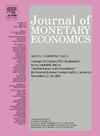我们常用模型中的异常冲击
IF 4.3
2区 经济学
Q1 BUSINESS, FINANCE
引用次数: 0
摘要
我们提出了一种方法,使通常的商业周期模型能够解释不寻常的 COVID 事件。大流行病以及公共和私人对它的反应由一个称为 Covid 冲击的新冲击来表示,它加载到支撑常规冲击的楔形上,并伴随着有关其演变的新闻。我们将我们的方法应用于一个标准的中等规模模型,利用 2020q2 数据估算负荷,并利用专业预测估算不断变化的新闻。Covid冲击占早期宏观经济动态的大部分,具有通胀和对经济活动的持续拖累作用,而且其大部分影响都是意料之外的。我们还展示了如何利用 Covid 冲击和大流行之前、期间和之后的数据来估计 DSGE 模型。本文章由计算机程序翻译,如有差异,请以英文原文为准。
Unusual shocks in our usual models
We propose a method to allow usual business cycle models to account for the unusual COVID episode. The pandemic and the public and private responses to it are represented by a new shock called the Covid shock, which loads onto wedges that underlie the usual shocks and comes with news about its evolution. We apply our method to a standard medium-scale model, estimating the loadings with 2020q2 data and the evolving news using professional forecasts. The Covid shock accounts for most of the early macroeconomic dynamics, was inflationary and a persistent drag on activity, and the majority of its effects were unanticipated. We also show how the Covid shock can be used to estimate DSGE models with data before, during, and after the pandemic.
求助全文
通过发布文献求助,成功后即可免费获取论文全文。
去求助
来源期刊

Journal of Monetary Economics
Multiple-
CiteScore
7.20
自引率
4.90%
发文量
90
审稿时长
74 days
期刊介绍:
The profession has witnessed over the past twenty years a remarkable expansion of research activities bearing on problems in the broader field of monetary economics. The strong interest in monetary analysis has been increasingly matched in recent years by the growing attention to the working and structure of financial institutions. The role of various institutional arrangements, the consequences of specific changes in banking structure and the welfare aspects of structural policies have attracted an increasing interest in the profession. There has also been a growing attention to the operation of credit markets and to various aspects in the behavior of rates of return on assets. The Journal of Monetary Economics provides a specialized forum for the publication of this research.
 求助内容:
求助内容: 应助结果提醒方式:
应助结果提醒方式:


